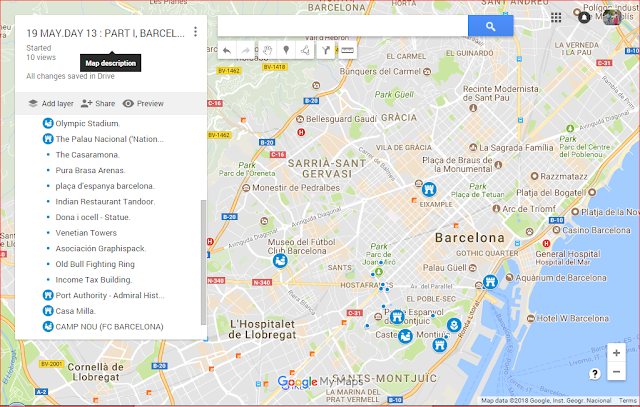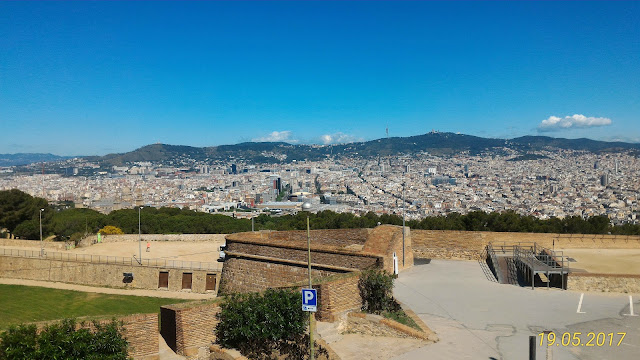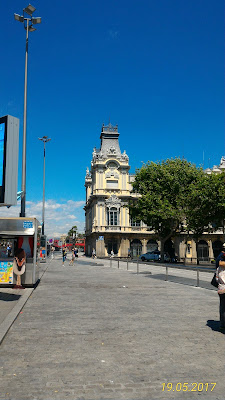19+20 MAY.DAY 13+14 : PART II ,BARCELONA, DAY TWO+THREE. MOROCCO,SPAIN,PORTUGAL TRIP.
Morning attractions upto Port Authority Square : Already covered in Blog PART I.
PART II, DAY 13 : sightseeing ramaining tarrractions, Dinner back to Hotel.
PART II : MAY 20 Day 14 Barcelona - Doha - Mumbai.
This is screen shot of map. Part II, of Day 13+14 Barcelona sightseeing + Air Routes.
Screenshot of map gives only limited information.On the other hand "interactive map"created by me in google"my maps" gives much much more information.For interactive map GO HERE..
OR go to link:https://goo.gl/jtdnEV
With this link interactive map will open in new window.
To navigate through this map use the left vertical panel of the map:
1.Size of the map can be vried by zooming-in or zooming-out as with normal map. For details zoom-in.
2.Panel gives contents of the map which are self explainatory.Placeing the cursor on any point say,FC Barcelona in this panle, will show location of Camp Nou, FC Barcelona on the map ringed by a white circle.A click on the same point will open a panel in the map itself showing information about Camp Nou, FC Barcelona Zoom in to see details of Camp Nou, FC Barcelona.All the placec inpanels have at least one photo of that place.If you want to see all the photos of Camp Nou, FC Barcelona GO HERE.
or go to link https://goo.gl/SC3Fps.This will open photos of not only of Camp Nou, FC Barcelona,but for ALL photos taken on Day 13 + 14 of 19 + 20 May 2017
3.Similar action can be repeated for all the points in interactive map.
PART II, Day 13,19 May 2017.
CAMP NOU,FC BARCELONA HOME STADIUM 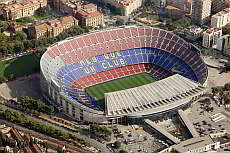
Camp Nou the largest football stadium in Europe.
Photo courtesy barcelona.de website.
FC Barcelona Home Stadium.
With statue of Laszio kubalaat FC Football stadium Barcelona.
The FC Barcelona is a club with many superlatives: it is the second largest sports club in the world, with the Camp Nou the games take place in Europe's largest football stadium and the club has compared to the European clubs the most enrolled fan bases.
Barça is an important part of Barcelona's and the Catalan history. On match days you can feel at every corner that the FC Barcelona is more than just a football club for the people here. That's what the motto is about: "Més que un club" (more than a club).
Just like you don't have to be religious to be fascinated by Gaudí's Sagrada Familia, you don't have to be a football fanatic to be electrified by the tension that's in the air on match days.
A visit to a home game or at least a visit of the stadium is just as much a "Must see" as for example the Sagrada Familia, La Pedrera or the beach.
Not withstanding what Barcelona.de,a barcelona travel guide web site, says about Camp Nou or FC Barcelona. I felt it was wasted one odd hour as I am not a fotball fan nor was any one else from our group.Particularly so because Barcelona had so many more, better attractions than the a look at the Stadium facade.To add insuil to injury we did not even enter the stadium,nor did we see The famous Museum of Barcelona Football Club,nor did we see any other building or facility.We Just saw the facade of the stadium , took photos and left for next place,Bit disappointed.
Some more photos of FC Barcelona Stadium
Facade FC Barcelona Stadium
Qatar Advertisement, Sponsor, FC football team at FC stadium in Barcelona.
With statue of Laszio kubalaat FC Football stadium Barcelona.
Francesc Miró-Sans i Casacuberta (1918 – 1989) was a former president of FC Barcelona.
Sketing Rink at FC Football Stadium.
OR go to the Link :
https://goo.gl/8Xtrpn.
This will not only open other photos of Camp Nou , but all the Photos taken at Barcelona on 19 & 20 May 2017.With this visit to Camp Nou or FC Football Stadium came to an end . Felt disappointed and a bit west of time.
Proceeded to next Place which was Casa Mila
BUT, before I write about Casa Mila, , just few words about the genius whose almost every building created by him had become a world Heritage Sites.He had built seven noteble buildings in and around Barcelona. Every one of them declared as World Heritage site !!
Antoni Gaudí i Cornet (1852 – 1926) was an architect from Reus, Catalonia, Spain.He is the best known practitioner of Catalan Modernism.
Seven properties built by him in or near Barcelona testify to Gaudí’s exceptional creative contribution to the development of architecture and building technology in the late 19th and early 20th centuries. These monuments represent an eclectic, as well as a very personal, style which was given free reign in the design of gardens, sculpture and all decorative arts, as well as architecture. The seven buildings are: Parque Güell; Palacio Güell; Casa Mila; Casa Vicens; Gaudí’s work on the Nativity façade and Crypt of La Sagrada Familia; Casa Batlló; Crypt in Colonia Güell.
Of these we saw two. Casa Mila and Sagarada Familia.Both will be coverd in this blog.
CASA MILA.

Casa Mila.The quarry house. It has no right angles
Photo courtesy web site bellesguardgaudi.com/en/blog/gaudi-buildings-barcelona.
The Casa Milà is one of Antoni Gaudí's last buildings, before he completely dedicated himself to the Sagrada Familia. The Casa Milà is one of the best known and most impressive buildings in Barcelona.
The house is also known as "La Pedrera", the quarry house because of the unusual construction. The large stone slabs were first mounted to the facade and then processed by the craftsmen.
The house is also known as "La Pedrera", the quarry house because of the unusual construction. The large stone slabs were first mounted to the facade and then processed by the craftsmen.
You can visit an art exhibition in the Belle Etage, an apartment on the top floor with furnishings from the 20s of the previous century, the top floor with an exhibition of works by Antoni Gaudí and especially the roof, with its famous ventilation openings, which partly look like soldiers.
The house itself consists of two houses, which are connected only by the facade, the ground floor and the roof. Each has its own courtyard and entrance.The front of the house looks like massive rocks, relaxed only by the wavy lines of iron and beaten ornaments. The bright stone of this otherwise colourless facade distinguishes it from all of Gaudí's other works and is very expressionistic.The house has a natural ventilation system, which makes air conditioning unnecessary and in Gaudi's plans were privided with an elevator, however the elevator wasn't built in the building until much later. You can move the interior walls. A concrete-steel construction, which requires no load-bearing walls makes this possible. The highlight of Casa Milà is without doubt the roof. Not only the overwhelming view of the city attracts the eyes of the visitors. Moreover the chimneys, ventilation shafts and stairwells with their fanciful colors and shapes attract them. Some chimneys look like soldiers, who watch over the roof.
We only saw the facade of Casa Mila from the road crossing.Spent may be 15 to 20 odd minutes looking at it. Leave alone seeing terrace did not even see the interiorof Casa Mila.
Another disappointment. Some more phitis of Casa Mila.
Casa Mila.
Casa Mila.
Casa Mila
Even the lamp posts at Casa Milla Square were designed by world famous artists.
There are many more photos of Casa Mila.
To see the themGO HERE.
OR go to the Link :
https://goo.gl/8Xtrpn.
This will not only open other photos of Casa Mila , but all the Photos taken at Barcelona on 19 & 20 May 2017.With this visit to CaMila or the querry house came to an end . Felt disappointed and a bit west of time.
Proceeded to next Place which was Sagarada Familia..
SAGARDA FAMILIA.

Catalan The Basílica i Temple Expiatori de la Sagrada Família,
OR
OR
English: Basilica and Expiato
Another view Sagarada Familia.
Side view.
Of the all numerous works By Antoni Gaudi, Sagarada Famila is the grandest and most famous landmark and one of the city's most impressive sights. The church is huge in its dimensions, which is why it is often referred to as a "cathedral".Though it is not so. In November 2010 Pope Benedict XVI consecrated and proclaimed it a "minor basilica",as distinct from a cathedral, which must be the seat of a bishop.
In the middle of the 19th century, José María Bocabella, president of the Holy Brotherhood, planned to build a church in Barcelona and dedicated it to the Holy Family "Sagrada Familia". He chose a property within the street grid in the former "Poblet" (small village),
a property closer to the city centre was not possible due to the already high land prices.
Initially, the diocese architect Francisco del Villar planned the church. He designed a church in the Gothic style and the work according to these plans began in 1882 with the construction of the crypt. Due to fundamental disagreements with Bocabella, he resigned.A few months later, in 1883, the young architect Antoni Gaudí took his place and found his life's work in it.
Under Gaudí, the church became so important because of its expansive dimension and lush design. Gaudí was convinced that the city would someday be known for "his" church.
At the time of his death at age 73 in 1926, less than a quarter of the project was complete. His work on the Sagrada Familia. His influence on the project was such that even after his death future architects of the project are following his plans and designs.
It has become longest project under construction in the world..
But all are certain: because of its immensity the Sagrada Familia, once completed, will surpass all the churches previously built by Christendom.
Moreover, as a church, the Sagrada Familia may not be viewed solely from an artistic point of view. During the visit one should also consider the profound religiosity, which is reflected in the symbolism of almost every single stone of the building with its facades and towers.
The church building of the Sagrada Familia is based on the classical construction of a five-aisled basilica. The middle ship clearly towers the others, each of the five is assigned a gate to the unfinished glory facade. There are also two side portals that lead to the penitential and baptistry chapel. The altar is located behind the nave, inside the apse, in the light of the many windows.
The Facades of the Sagrada Familia
.
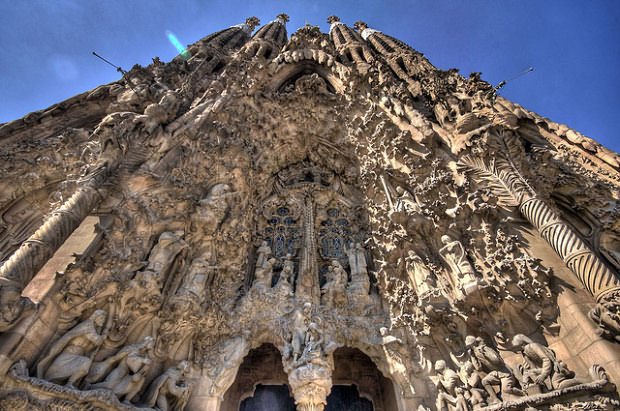
Nativity façade,
The Nativity faces East.The name comes from the fact that it tells the story of Jesus’ birth, childhood and young manhood.
Photo &Text courtesy promptguides.com.
Highly ornamental Nativity Facade .My photo.
Some details Nativity Facade .My photo

Passion Facade.
Strong lines and clean cuts of Passion Facade are in stark contrast to Nativity Facade.
Photo Courtesy exploration-online.com/
Some details Nativity Facade .My photo.
.
Passion Facade faces West.
In contrast to Nativity facade this shows Crucifiction, death of Christ.
Some details Passion Facade .Clean cut,stark images Passion Facade.
Another View.Passion Facade.
There are the various facades of Sagarada Familia.1. Nativity Facade orThe Facade of Christ's Birth (Christmas Facade), 2. The Three Portals of the Facade of Christ's Birth,The Tree of Life is part of this facade. 4.The Facade of the Ordeal AND 5 .The Facade of the Bliss.
Their grandness has to be seen to be believed.
It would be very interesting to read the details to really know th complexities, the beauty of and the genius of Antono gaudi.To maintain proportion of blog length a link to web site is given Please do read it.
Interior of Sagarada Femilia.
Interior Saragarada Familia.Staine glss windows.
Interior Saragarada Familia.Staine glss windows.
Interior Saragarada Familia.Staine glss windows.
Interior Saragarada Familia
The church building of the Sagrada Familia is based on the classical construction of a five-aisled basilica. The middle ship clearly towers the others, each of the five is assigned a gate to the unfinished glory facade. There are also two side portals that lead to the penitential and baptistry chapel. The altar is located behind the nave, inside the apse, in the light of the many windows.
Just as the facades are characterised by a multi-layered symbolism, the floor plan of the church is full of symbols. Every door, every pillar and almost every surface has its own specific or symbolic meaning. These allusions and parables refer to the individual Catalan and important Spanish dioceses, to every church in Latin America and to each of the five continents. Additionally, the apostles, great founders of the order and especially revered saints, the theological virtues, the sacraments and much more are referred to again and again.
The Vault and Column System inside the Basilica.

Pillars transform the interior of the temple into a stone palm forest,
Sagarada Familia.
Photo courtesy wikimediacommons.org.
Branch like Columns support the vault .Which has glass opening for natural light .
Branch like Columns support the vault . Glass windows for natural light.
Gaudi besides being a pious and religious person was also a lover of nature.He wanted the roof and structural load bearing columns to be in the shape of trees.To achieve this he carried out Through research to determine how the structural load could be distributed and so was able to fulfil his objective
Gaudí's columns are inclined and branched like trees. The weight is guided directly over the pillars into the ground - all of that without load-bearing facade or outer longwall sheets. The result of this ingenious solution is spectacular: the pillars and the vaults they carry transform the interior of the temple into a stone palm forest, with an abundance of light streaming in through the large windows and through the vault.
The straight and partially inclined columns are decorated with grooves. This creates the impression that the material that makes up the columns has stretched. Above, the pillars branch so that each of them can support multiple points on the ceiling. All sections of the roof are supported by such branched columns.
Finally, the columns are made of materials of different hardness. The longest and thickest columns are made of reddish porphyry, a very hard, volcanic rock. The darker, slightly smaller columns are made of basalt, the brighter pillars of granite and the outermost row of columns in the church building of a relatively soft rock from the mountain of Barcelona, the Montjuïc. The "smallest" columns carry the choir.
Finally, the columns are made of materials of different hardness. The longest and thickest columns are made of reddish porphyry, a very hard, volcanic rock. The darker, slightly smaller columns are made of basalt, the brighter pillars of granite and the outermost row of columns in the church building of a relatively soft rock from the mountain of Barcelona, the Montjuïc. The "smallest" columns carry the choir.
The Five Naves,
The Apse of the Sagrada Familia.
The Towers of Sagrada Familia.
The Rosary Chapel.
The Crypt.
The Cloister of the Sagrada Familia is Unusual.
Each ad every aspect, The design, the plans, the architectural beauty, gigentic dimensions the symbolism and the magnificance of each and every structure mentioned above is living proof of his genius.
Constrains of space and limit to the patience of readers prevents me from describing themin details . But my source for this is open source Tourism Guide of Barcelona at the website /www.barcelona.de/en/b
I very strongly recommend readint it to really konw Sagarada Familia.
By the time we returned earphones given to us for the tour of Sagarada Familia it wae 7:00 PM.
So we left Sagarada Familia and went to Shanti Restaurant for Dinner.Then straight to Hotel and bed as we had to get up early to catch flight for return journey .
END 19 MAY 2017 , DAY 13 OF THE TOUR.
20 may, Day 14.Morocco, Portugal,Spain Trip .
Last day of trip. Got up very early. Reached Barcelona Airport fora flight to Doha . From there an onward flight to Mumbai and inally to Nagpur .
Rots followed are given in the map.
Overall it was agood trip. With the plus and minus points of a Group Tour.
END MOROCCO,PORTUGAL SPAIN TRIP.


























